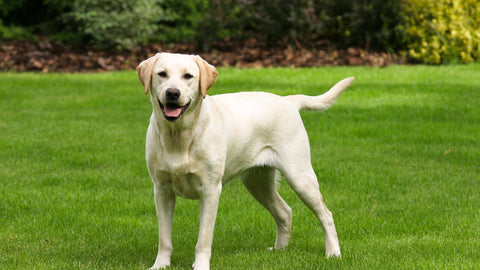Contents
- Introduction to the Labrador
- Appearance of the Labrador
- Coat and colours of the Labrador
- How big can a Labrador get?
- The Labrador's character
- Training the Labrador
- Who is the Labrador suitable for?
- Is the Labrador a family dog?
- Labrador care
- Labrador nutrition
- How much does a Labrador shed?
- What is the average age of a Labrador?
- Typical diseases of Labradors
- How much does a Labrador puppy cost?
- What should you watch out for when buying a Labrador?
- Labrador profile
Introduction to Labradors
The Labrador Retriever is one of the most popular dog breeds worldwide. It originates from Newfoundland and was originally bred as a hunting and working dog, particularly for water work. Today, the Labrador is not only in demand as a family dog, but also as a guide dog, therapy dog and in rescue services. Its friendly nature, willingness to learn and versatility make it an ideal companion for people of all ages.
Appearance of the Labrador
The Labrador Retriever is a powerfully built, medium-sized dog with a muscular and compact build. Its physique is well proportioned, with a broad chest and strong limbs. Their eyes are brown or hazel in colour and radiate intelligence and friendliness. Labradors have drooping ears that lie close to the head, and a broad muzzle. Their tail is characteristically thick and is called an ‘otter tail’ because it is very broad at the base and tapers towards the end.
The Labrador's coat and colours
The Labrador's fur is short, dense and water-repellent, which is particularly useful for them when working in water. Labradors come in three main colours: black, yellow and brown (chocolate). Yellow can range from a light cream to a deep fox red. The fur has two layers, with a dense undercoat that protects against cold and wet conditions.
How big can a Labrador get?
Males usually reach a shoulder height of 56 to 57 cm, while females are slightly smaller, between 54 and 56 cm. Their weight varies between 25 and 36 kg, depending on their sex, genetics and general fitness.
The Labrador's character
Labradors are known for their friendly, gentle and balanced nature. They are very people-oriented, intelligent and eager to learn. Their pronounced ‘will to please’ – the desire to please their owners – makes them easy to train and versatile. Labradors are generally playful, patient and have a high level of social tolerance, both with people and with other animals.
Training a Labrador
Training a Labrador is usually straightforward due to their intelligence and willingness to learn. However, it requires consistency, patience and positive reinforcement to train a Labrador properly. Early socialisation is important to teach them how to interact with their environment from the very beginning. Labradors are not dogs that require harsh training – they respond best to praise, treats and playful motivation.
Who is the Labrador suitable for?
The Labrador is an active dog and is particularly suitable for people who can invest a lot of time and energy in activities with their dog. It is a good match for sporty people, families and dog owners who enjoy being in nature. Labradors are also often used as companion dogs for senior citizens or people with disabilities, as they are very adaptable and patient.
Is the Labrador a family dog?
Yes, the Labrador is an excellent family dog. Its friendly and patient nature makes it an ideal companion for children. It is playful, but also very gentle, which makes it a trustworthy friend in the family's daily life. Nevertheless, the interaction of small children with the dog should always be supervised to avoid misunderstandings or accidental injury.
Looking after your Labrador
Looking after your Labrador is relatively easy. Brushing them regularly helps to remove dead hairs and keep their fur clean and shiny. Since Labradors love to swim, their fur should be dried thoroughly after bathing in lakes or rivers to avoid skin irritation. Their ears should also be checked and cleaned regularly, as they are prone to infections.
Labrador nutrition
Labradors tend to be greedy eaters, so their diet should be carefully monitored to avoid them becoming overweight. It is essential to provide them with a balanced, high-quality diet that supplies them with all the essential nutrients they need. Labrador Retrievers should get enough protein for muscle building and healthy fats for energy. In addition, treats should be used sparingly and a regular feeding routine should be maintained.
How much do Labradors shed?
Labradors shed hair all year round, but more so in spring and autumn when they are changing their coat. Regular brushing can help to minimise hair loss and keep the coat healthy. The Labrador should be brushed more often during the coat change to remove loose hair.
How old does a Labrador get?
The average life expectancy of a Labrador is between 10 and 14 years. As with all dogs, lifespan depends on various factors, including nutrition, care, exercise and genetic predisposition.
Typical Labrador diseases
Labradors are prone to some breed-specific diseases, in particular hip and elbow dysplasia, which can lead to restricted mobility. They can also suffer from hereditary diseases such as progressive retinal atrophy (PRA), an eye disease that can cause blindness. Labradors also tend to be overweight, which in turn can lead to heart problems and joint strain. Regular check-ups at the vet are therefore important.
How much does a Labrador puppy cost?
The price of a Labrador puppy can vary greatly depending on the origin and breeding quality of the dog. In Switzerland, the price of a Labrador puppy from a reputable breeder is usually between CHF 1000.00 and CHF 2000.00. The parent animals should have been tested for hereditary diseases and the puppies should be well socialised and receive veterinary care.
What should you look out for when buying a Labrador?
When buying a Labrador, you should definitely look for a reputable breeder. They place a high value on healthy parent animals that have been tested for hereditary diseases, and provide the puppies with good socialisation in the first weeks of their lives. A responsible breeder will not only provide information about the health and behaviour of the parent animals, but will also address the needs of the puppy after purchase. It is advisable to visit the breeding facility in person to get an impression of the conditions in which the animals are kept.
Breed profile: the Labrador
Breed: Labrador retriever
Origin: Newfoundland, Canada
Height: males 56–57 cm, females 54–56 cm
Weight: 25 –36 kg
Coat: Short, dense, water-repellent
Colours: Black, yellow, brown
Life expectancy: 10–14 years
Character: Friendly, balanced, willing to learn , playful
Suitability: family dog, working dog, therapy dog and guide dog for the blind
Grooming requirements: medium, regular brushing required
Exercise requirements: high, lots of physical and mental



Comments (0)
There are no comments for this article. Be the first one to leave a message!